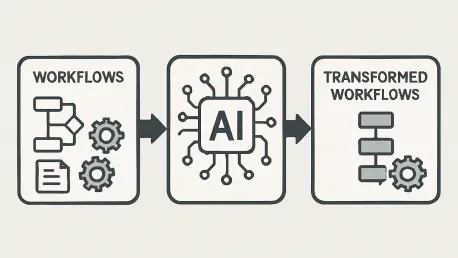Introduction to AI in Canadian Workflows
In the rapidly evolving landscape of modern business, a staggering statistic reveals that only 12.2% of Canadian businesses reported using AI for goods and services in the current year, a modest increase from 6.1% in the prior period, highlighting a significant gap in leveraging technology that could redefine efficiency and productivity across industries. The potential of artificial intelligence to streamline operations and reduce mundane tasks remains largely untapped in Canada, prompting a critical need for structured integration strategies.
The purpose of this FAQ is to address common questions surrounding the transformative power of AI in workflows, particularly for Canadian organizations. It aims to provide clear, actionable insights into how AI can be practically implemented to enhance knowledge work processes. Readers can expect to explore key challenges, solutions, and frameworks that facilitate safe and measurable AI adoption.
This content delves into specific programs and approaches that bridge the gap between experimental AI projects and real-world application. By focusing on governance, compliance, and tangible outcomes, the discussion offers a comprehensive guide for businesses seeking to modernize their operations. The following sections break down essential topics to equip leaders with the knowledge needed to embark on this technological journey.
Key Questions on AI Transformation
How Significant Is the Challenge of AI Adoption in Canada?
The adoption of AI in Canadian businesses remains a pressing concern, with uptake rates still lagging behind global benchmarks. Many organizations struggle with transitioning from pilot projects to scalable solutions, often due to a lack of structured guidance and concerns over compliance with local regulations. This hesitation results in missed opportunities to enhance productivity and reduce operational inefficiencies.
Addressing this challenge requires a shift from sporadic experimentation to systematic integration. A notable barrier is the coordination cost associated with inefficient workflows, such as redundant updates and duplicated efforts, which AI has the potential to minimize. Understanding the scale of this issue is the first step toward crafting strategies that can effectively modernize business processes.
What Frameworks Exist to Support AI Integration in Workflows?
One prominent solution to the adoption challenge is a structured program designed to guide organizations through a phased approach to AI implementation. Such initiatives focus on embedding AI features directly into live workflows, ensuring that the technology aligns with everyday operations. This method emphasizes best-practice system design and includes support for adoption sprints and change management to ease the transition.
A key aspect of these frameworks is their alignment with Canadian privacy and governance standards, such as PIPEDA for private-sector entities and provincial regulations like Quebec’s Law 25. By incorporating privacy impact assessments and risk controls from the start, these programs ensure ethical deployment. Additionally, adherence to federal guidelines, including the Treasury Board’s Algorithmic Impact Assessment, reinforces a commitment to responsible AI use.
Customer experiences further validate the effectiveness of structured frameworks. For instance, feedback from a major publication highlighted significant improvements in workflow automation and operational efficiency after adopting AI through a guided program. This evidence underscores the value of a governed approach in achieving measurable results.
Why Is Compliance with Canadian Regulations Crucial for AI Deployment?
Compliance with Canadian regulations is a cornerstone of safe AI adoption, given the country’s stringent privacy and data protection laws. Businesses must navigate a complex landscape of federal and provincial rules to avoid legal pitfalls and maintain public trust. Non-compliance can lead to penalties and reputational damage, making it a critical consideration for any organization exploring AI solutions.
Structured AI programs address this by embedding compliance into their core design, ensuring alignment with frameworks like Alberta and BC’s PIPA. They also follow voluntary codes of conduct for generative AI, promoting ethical practices. This proactive stance not only mitigates risks but also builds confidence among stakeholders that AI tools are deployed responsibly.
How Can AI Reduce Coordination Costs in Knowledge Work?
Coordination costs, such as inefficient handoffs and repetitive status updates, are a significant drain on productivity in knowledge work. AI offers a powerful solution by automating routine tasks and streamlining communication, allowing teams to focus on high-value activities. This shift can transform how organizations operate, moving away from administrative burdens to actual delivery.
Programs designed for AI integration often target these inefficiencies by embedding intelligent features into existing systems. For example, automating updates within project management tools can save countless hours previously spent on manual tracking. The result is a more agile workforce, better equipped to handle complex challenges without being bogged down by procedural overhead.
Testimonials from businesses that have adopted such solutions reveal substantial time savings and enhanced operational flow. A collaborative training approach further ensures that teams can sustain these improvements independently, amplifying the long-term impact of AI on reducing coordination costs.
What Measurable Outcomes Can Businesses Expect from AI Implementation?
The promise of AI lies in its ability to deliver tangible, measurable outcomes for businesses willing to invest in proper integration. Beyond theoretical benefits, organizations can expect improvements in efficiency, cost reduction, and enhanced decision-making capabilities. These outcomes are often quantified through metrics like time saved on routine tasks or increased project delivery speed.
Structured programs prioritize defining success metrics from the outset, enabling businesses to track progress and adjust strategies as needed. A complimentary consultation, sometimes valued at significant amounts, can help map out specific use cases and set realistic goals. This tailored approach ensures that AI delivers value aligned with organizational priorities.
Evidence from early adopters illustrates the potential for operational transformation. Reports of streamlined processes and empowered teams highlight how AI can shift focus from mundane tasks to strategic initiatives, offering a competitive edge in a dynamic market.
Summary of AI’s Role in Workflows
The insights provided in this FAQ underscore the transformative potential of AI for Canadian businesses, addressing the low adoption rates through structured, governed approaches. Key points include the importance of overcoming integration challenges, leveraging frameworks that prioritize compliance, and targeting coordination costs to boost productivity. These elements collectively form a roadmap for organizations aiming to embed AI into their core operations.
A significant takeaway is the emphasis on measurable outcomes, supported by real-world examples of efficiency gains and workflow improvements. Compliance with Canadian regulations remains a critical factor, ensuring that innovation does not come at the expense of ethical responsibility. This balance of progress and governance is essential for sustainable AI adoption.
For those seeking deeper exploration, additional resources on Canadian privacy laws and AI governance frameworks are recommended. Engaging with expert consultations or industry summits can also provide further clarity on tailoring AI solutions to specific business needs. These avenues offer valuable opportunities to expand understanding and refine implementation strategies.
Final Thoughts on AI Transformation
Reflecting on the journey of AI adoption in Canada, it becomes evident that the path from interest to impact demands careful planning and robust support systems. The strides made through structured programs highlight a turning point, where technology meets practicality in reshaping workflows. This evolution marks a significant chapter in how businesses approach innovation with accountability.
Consideration of these insights prompts a vital next step for leaders: evaluating how AI could address specific inefficiencies within their own operations. Exploring available programs or consultations proves to be a practical starting point for many. Such actions pave the way toward not just adopting AI, but ensuring it delivers lasting value in a competitive landscape.









